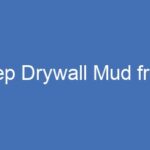If you’re embarking on a drywall project, it’s likely you’ve conducted some research on fast-drying joint compound. While you might have a grasp of what drywall mud does, you could be puzzled by the multitude of options available.
Furthermore, the distinction between these products can be elusive. Let’s elucidate the function of each type of joint compound and when to utilize them.
Understanding Joint Compound
Joint compound, sometimes referred to as drywall mud or sheetrock mud, is employed to conceal drywall surfaces.
It’s a gypsum-based mixture that serves to connect drywall seams and corner beads, enhancing structural integrity and camouflaging imperfections to prepare surfaces for painting.
Professionals may refer to joint compound as Durabond, a specific brand produced by USG, the same company responsible for Sheetrock Brand drywall.
Application of Joint Compound and Drywall Tape
Before delving into the various types of drywall mud, it’s imperative to cover the process of taping and mudding drywall and the use of drywall tape.
Application of joint compound and tape occurs in the latter stages of the drywall installation process.
Once drywall sheets have been measured, cut, and attached to the walls, joint compound and tape are applied to cover seams and screw heads, creating a seamless and uniform surface.
The Three-Coat Process
The three-coat process commences with the initial application of compound, allowing it to dry and harden. Corner beads are applied, and joint tape is used on the drywall seams.
Following the drying of the first coat, a second coat is added, followed by a third and final coat.
Each coat serves a distinct purpose. The first and second coats focus on coverage, while the third coat aims for a smooth and even finish. After the third coat dries, it can be sanded to achieve a polished surface.
Comparing Joint Compound and Plaster
Joint compound has been the preferred choice for finishing drywall since the early 20th century.
The primary disparity between drywall mud and plaster of paris, typically found in structures constructed before the early 1900s, lies in the hardening properties of plaster.
Drywall mud, or hydrated calcium sulfate, forms when dry powder mixes with water. While it resembles plaster, it lacks the cement-like hardening associated with lime and aggregate plaster mix.
Types of Joint Compound
Joint compounds can be categorized into two main groups:
- Fast Drying (Also known as Quick Setting or “Hot” Mud)
- Premixed Drywall Mud
Quick Setting Drywall Mud
Commonly referred to as hot mud or fast-drying mud, this type of joint compound is available in powder form, packaged in plastic-lined boxes or paper bags.
The gypsum dust is mixed with water, triggering a chemical reaction that causes the mud to transition from a liquid to a solid state. Some believe it’s named “hot mud” due to the heat generated during this chemical reaction.
Another explanation is that the mixture sets rapidly once water is added, necessitating swift application to avoid premature hardening.
Regardless, it’s crucial to prepare only as much as you can use before it solidifies.
Multiple Coats in Less Time
Fast-drying joint compound is available in various drying time options, which can vary by manufacturer, ranging from 90 minutes to 20 minutes. The shorter drying times enable the application of multiple coats in a shorter period.
This feature is particularly useful for applying several coats in a single day, as well as for patching and repairing problematic areas where extended drying would pose challenges.
Many professionals consider hot mud to provide a crack-resistant, strong base coat. However, it is seldom used as a finishing coat due to its difficulty to sand to a smooth finish.
Professionals understand that all joint compounds shrink to some extent, and the degree of shrinkage depends on the type of mud applied and various site-specific factors.
USG 20 Minute Easy Sand Joint Compound
The lightweight USG 20 Minute Easy Sand compound is easy to handle, exhibits minimal shrinkage, and boasts superior bonding properties.
It is ideal for small patching and laminating drywall, and it is recommended to use mesh tape on joints where quick-setting compound is employed.
Premixed Drywall Compound
Premixed regular joint compound is a convenient option, commonly available in 5-gallon buckets.
Although it may need some thinning with water before application, it is the most familiar type of joint compound to many people.
The convenience it offers comes at the cost of longer drying times, and it can be more expensive.
The most common types of premixed taping compound are All-Purpose, All-Purpose Lightweight, and Topping.
All-Purpose Drywall Compound
True to its name, All-Purpose joint compound can be used for a wide range of purposes, including the first coats, tape embedding, minor patching, and filling nail holes.
Its ease of use and versatility make it a favorite among DIY enthusiasts. However, finishing and sanding this regular mud can be more challenging than with other compounds.
All-Purpose Lightweight Drywall Mud
As the name suggests, All-Purpose Lightweight joint compound is a lighter alternative to the standard All-Purpose compound.
Some professionals believe that its lightweight nature may result in lower bonding power and structural strength compared to other types of mud. Nevertheless, it is a favorable choice for a finishing coat, as it is easier to sand.
Topping Compound
Topping compound is likely the least utilized among all drywall mud options. Nevertheless, it is a suitable choice for finishing and is often used for texture applications and skim coating.
This compound boasts a whiter color than others and experiences minimal shrinkage during the drying process.
When to Choose Fast Drying Joint Compound
As previously mentioned, the setting and drying times of joint compound are critical factors in determining whether to opt for fast-drying or premixed compounds.
Premixed compounds offer convenience and can be applied in multiple coats, but this process may span several days. In contrast, fast-drying compounds expedite the process but demand rapid application and taping.
It’s essential to note that the setting and drying times may vary depending on environmental conditions. High humidity or cold temperatures can significantly extend drying times.
Drying Times Affected by Job Site Conditions
To accelerate the drying process when using premixed compound, applying thinner coats rather than thicker ones is advisable.
Additionally, the use of space heaters, hairdryers, or heat guns directed at freshly applied mud can expedite drying.
Ultimately, the choice between fast-drying and premixed compounds often hinges on the available time to complete the project. Projects with tight schedules often require faster drying to allow painters to commence their work promptly.
Veterans in the industry are well-acquainted with the need for painters to start their work before the joint compound has had sufficient time to dry properly.
Choosing Fast Drying Drywall Compound Wisely
Fast-drying compound is the preferred choice for quick applications, small areas, patching, gouges, minor holes, and robust initial coats.
For larger projects or extensive areas, as well as for second and finishing coats, all-purpose premixed versions are generally recommended.
When mixing and matching joint compounds, it is advisable to adhere to the manufacturer’s guidelines. While most drywall muds are compatible, checking the manufacturer’s recommendations for compatibility is a best practice.
Identifying the Fastest Drying Joint Compound
- USG Easy Sand – 5 Minute Dry Time
- ProForm Quick Set Lite – 5 Minute Dry Time
- DAP Fast Dry Premium Spackling – 15 Minute Dry Time
- Gorilla Heavy Duty Wall Repair Spackle – 15 Minute Dry Time
- USG Easy Sand – 20 Minute Dry Time
- DAP Fast Patch Compound Powder – 30 Minute Dry Time
- USG Easy Sand – 45 Minute Dry Time
- USG DuraBond – 90 Minute Dry Time
Expediting Drying of Joint Compound
- Apply Thinner Coats of Mud: Use ample pressure on the trowel to prevent excess mud buildup on the wall. Remove surplus mud and return it to the mud pan.
- Utilize a Dehumidifier: Removing moisture from the air and the applied drywall mud can expedite drying.
- Use Hot Mud: Although more challenging to work with, hot mud is formulated for rapid setting and will dry faster than regular mud.
- Employ a Drying Gun: Directing dry heat onto the drywall mud accelerates drying. Drying guns designed for drywall work or even a hair dryer can be helpful.
Joint Compound vs Spackle
Spackle is used for repairing small dents, dings, and holes in drywall and dries quickly, sometimes within 15 minutes. It’s an excellent choice for small home improvement projects and touch-ups.
When expedited drywall repairs are needed before painting, spackle can be the optimal solution. Certain spackle brands, such as DAP, offer fast-drying products that resist shrinkage and cracking, often requiring only a single application.
tag: # Fast Drying Joint Compound







